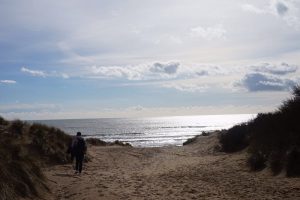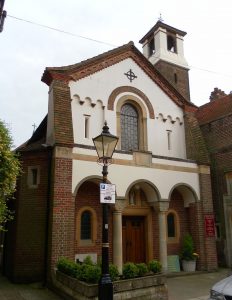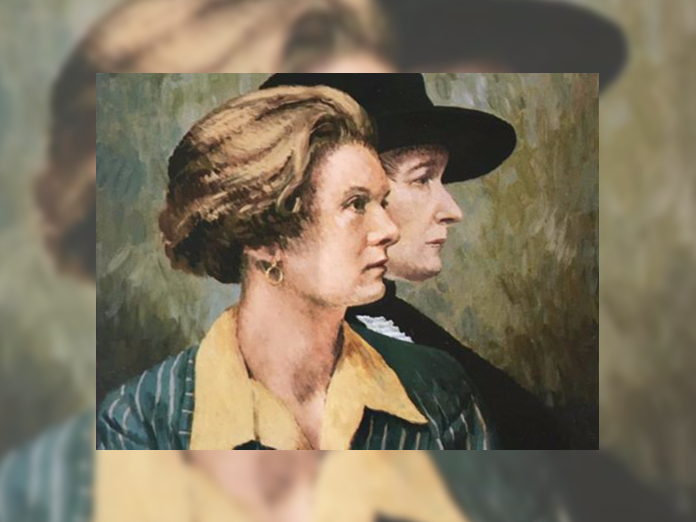One of the most immediately noticeable things in Rye, resulting from the nationwide coronavirus lockdown, is the sudden dearth of day-trippers and the compounding parking problems.
Parking provision in Rye might seem a fairly recent phenomenon but, in a town built as a bustling medieval port designed for shanks’ pony and the horse and cart, the advent of the internal combustion engine very quickly created problems. Nearly a hundred years ago, parking was already causing difficulty for townsfolk and visitors alike.
One such instance, in the early 1930s, beautifully reflects the character of Rye resident Lady Una Troubridge who, with her Eton crop hairstyle and monocle, was an instantly-recognisable and familiar figure in and around town.
“Please do not park outside my house”
Finding a day-tripper’s car parked outside her home, the Black Boy, she stuck a message on the windscreen which read: “Please do not park outside my house, The Lady Una Troubridge.”
She had gained her title in 1919 when her estranged husband, Admiral Troubridge, had been knighted. Technically, putting ‘the’ before Lady is usually reserved for someone married to a baron or higher.
Troubridge shared her home with her lover Radclyffe Hall, writer of the landmark novel of lesbian love, “The Well of Loneliness”. Hall had been born Marguerite Radclyffe Hall but dropped her first name to create the androgynous-sounding Radclyffe Hall as a nom de plume. She was, however, known to her friends simply as ‘John’.
Hall dressed in men’s clothing (she is said to have owned ninety-four neckties), smoked a pipe and her hair was cut at the gentleman’s hairdressers Truefitts of Bond Street. When in Rye, a tailor would come from Brighton to measure her for bespoke smoking jackets and suits. It’s small wonder that the local children thought she was a man.
But what brought Hall to Rye?
Soon after its publication in 1928, her lesbian novel attracted the attention of the editor of The Sunday Express who waged a campaign against it in the newspaper’s columns. In an article entitled ‘A Book That Must Be Suppressed’, he wrote: “I would rather give a healthy boy or healthy girl a phial of prussic acid than this novel.”
This, despite its only references to same-sex love being “she kissed her full on the lips, as a lover” and “that night they were not divided.”
Hall’s novel soon found itself in the dock on a charge of obscenity in a high-profile trial at Bow Street. Eminent writers of the day came to its defence, including household names such as George Bernard Shaw, Vita Sackville-West and HG Wells. Authors Virginia Woolf and EM Forster even attended the trail ready to act as witnesses for the defence if necessary, though neither was ever called to the stand.
All their efforts were to no avail. The book was banned and the chief magistrate ordered all existing copies to be destroyed. The publisher appealed and lost. It was not until 1949 – six years after Hall’s death – that this ban was finally lifted and the novel republished.
During the trial, Hall and Troubridge would motor down from London to Rye to escape the publicity and here they found solace and – apparently – parking spaces and had bought a property within less than two years.

They would walk their dachshunds on Rye Marshes and Camber Sands sometimes in the company of their friends, the Smallhythe ménage à trois, theatre director Edith (Edy) Craig and her lovers the writer Chris St John and artist Tony Atwood, whom Hall and Troubridge affectionately referred to as “The Old Trouts” because – despite what their names might suggest – all three were women.
Hall often walked alone, though, when looking for inspiration. It has been said by one of her biographers that “one of Radclyffe Hall’s most intense relationship was her relationship with Rye.”
The masts of moored boats moving gently
Her love of the town is clearly evident in her 1936 novel, ‘The Sixth Beatitude’, in which she captures the unique beauty of the area: it roof-tops blazing in the sunset, the cobble stones shining in the rain after a storm, the masts of moored boats moving gently in the tidal flow of the River Rother.

As well as leaving a loving portrait of Rye in her writing, Hall left another legacy through her involvement with the Catholic church of St Anthony of Padua in Watchbell Street, having converted to Catholicism in 1912. She donated some of her substantial fortune to its rebuilding in the late 1920s, providing funds for the roof, pews and the striking Byzantine Rood Cross of Christ the King that still hangs above the altar.
Another aspect of the current lockdown, in the addition to the freeing up of parking spaces, is being left to our own devices for entertainment and diversion. It is a challenge which the fascinating and larger-than-life characters of Radclyffe Hall and her partner Una, Lady Troubridge would have been more than equal to.
* The Black Boy, incidentally, was named by Troubridge after the swarthy King Charles II who was supposed to have stayed there.
Image Credits: Rye Arts Festival , Kevin McCarthy , Mags Ivatt .




As a relatively new resident to Rye I’ve felt it surprising that so little is made of this ground breaking lesbian author. The Recent TV series “Gentleman Jack” which dramatised the diaries of Ann Lister (1791-1840) has made Shibden Hall and Halifax a Mecca for gay women and visitor numbers have dramatically increased. There was even a festival in Halifax for Anne Listers birthday attended by thousands. Comparatively, Radcliffe Hall’s contribution to literature is, undoubtedly, greater and her outrageously flamboyant lifestyle just, if not more, as interesting. There is a lot to associate this trailblazing lesbian novelist with Rye which would surely have an equal appeal and could have the same affect as what’s happened in Halifax.
I agree with the comments above by Mags Ivatts. It’s a shame the article depicts Radclyffe Hall as an oddity ‘children thought she was a man’. She was incredibly brave to write and publish The Well of Loneliness at the early part of the twentieth century when gay women were invisible and ostracised. Rye should indeed promote and celebrate this famous author who was so courageous and groundbreaking. It’s a shame the author refers to her partner una troubridge as her ‘lover’. It is more respectful to call her Johnny’s partner. They shared their lives for many decades and now share a grave in Highgate.
I agree. I have read and reread Radclyffe Hall’s books many times over the last 30 years. The only one I cant reread is Adam’s Breed as it made such a profound impression on me at the time that I need to keep the memory intact and separate. The Sixth Beatitude is also a very harrowing read but very worthwhile. Prepare to cry your eyes out. And The Well of Loneliness is rightly a classic.
Thank you for your comments on my article which were interesting and thought-provoking.
Yes, Hall was incredibly brave. I agree that it’s a shame, and surprising, that she is not remembered and celebrated in the same way as some other trailblazers. A good local comparison is the Smallhythe group. The National Trust seem to have embraced their history and lives.
I also agree that she was not an oddity. She was of course part of a community that included other well-known writers such as Colette and Natalie Barney. I believe, incidentally, that Una Troubridge used some of the time she was living in Rye to translate Colette.
My line regarding children mistaking Hall for a man was based on the fact that she took a great deal trouble to deliberately dress in ‘men’s clothing’ and have her hair styled like that of a man, and that she would no doubt be pleased by this misapprehension. I made no mention of this being odd.
I chose ‘lover’ rather than partner, when first linking Troubridge to Hall, to make it clear that they were in a same sex-relationship, rather than simply being companions, and, perhaps to give it more of the flavour of the times. ‘Partner’, in that context, would have been misleading. Having said that, I totally agree that ‘lover’ could easily be misconstrued to describe a purely sexual relationship rather than a full, loving, life-sharing one, which is why I refer to them as partners in the final paragraph.
Hall seems to have had an interesting – and complex – relationship with St Anthony’s church and its priest Fr Bonaventura. Does anyone know anything about this? I’d love to know.
She was never ‘Lady Una Troubridge’. She was born Margot Taylor, and married an Admiral called Ernest Troubridge (with whom she had a daughter called Andrea). Ernest, long after they had separated, was knighted; she then chose to style herself ‘Una, Lady Troubridge’. (When her lover Radclyffe Hall* died, Una had all Radclyffe’s (mens’) suits altered to fit her – I wonder if by a Rye tailor?).
*Whose Christian name was the rather more prosaic Margaret.
It is also worth noting that it was Vita Sackville-West who first named the trio who lived at Smallhythe Place “The trouts”. V S-W was a consistent friend of Miss Craig and her companions, and was instrumental in the negotiations with the National Trust to take over the property. (See: James Lees-Milne ‘People and Places’, pp 111-119, John Murray, 1992).
Thank you, Heloise, for your article which I found interesting and timely as I have just finished reading Sally Cline’s biography of Radclyffe Hall, ‘A Woman called a John.’ This particular lockdown exercise has been both fascinating and moving. Since retiring back to Rye a few years ago I have read all of Radclyffe Hall’s novels and found them edifying. Most of her main characters generally have a nobility of spirit and much of her prose is beautiful and poetic. In my opinion she deserves to be more widely read and acclaimed. As far as her relationship with the local Catholic Church is concerned, I have had a number of interesting conversations about this with the lady who runs the second hand bookshop in Lion Street. Maybe she can throw a little more light on this?
Thank you for your suggestion about the book shop, Christopher. And how interesting about Troubridge having Hall’s clothes altered to fit her.
Radclyffe Hall had beautiful quality clothes made by London houses Aquascutum and Jaeger which is why Una Troubridge may have kept them. I think it likely that the Catholic Church in Rye does not wish to celebrate a brave and groundbreaking parishioner because she was homosexual.
Just now seeing this and quite enjoyed it. I was thrilled to discover the blue plaque on a day trip from London a couple of years ago. I was somewhat spontaneously looking for the homes of my great grandfather and other ancestral family.
I’m all in for a John/Una Day/Fest! I expect part of the challenge is not having a Shibden Hall handy. And, yes, I doubt St Anthony of Padua RCC cares to host such an event, despite being the benefactor of Hall’s generosity, unlike St. Mary’s.
Any thoughts as to why Radclyffe Hall actually wanted and chose to convert to Roman Catholicism? I’m in the states, but I should think that the Anglican COE would have been quite similar in service to the Roman Catholic Church, yet still a bit less oppressive, perhaps?
Also curious if E.F. Benson, who was mayor for some of John/Una’s Rye time, socialized with them and/or derived influence from them for his stories.
Una was buried in Rome in 1963 and not in the catacomb at Highgate cemetery.Johnny lies there with her first partner Mabel Batten Unfortunately Una’s grave was cleared in the 1970s
Fab author – snappy dresser: what’s not to like. Yeah Una was a bit of a snob but what a couple they must have made in poor old Rye back in the day. Need more celebrations of Radclyffe – may be a mention of them in the ‘Writing Ourselves In’ at the Rye Arts Festival on 23rd September at The Brewery Yard Club?
Wow, thank you for the article. We also had good conversations with the friendly lady of the second hand bookshop. We have been to Rye twice and we hope we can come again.
‘The Well of Loneliness’ is indeed a beautiful read and a brave one considering the times in which it was written. It is however, another novel by Radclyffe Hall ‘The Unlit Lamp’ which is the one I am really moved by. It is haunting, desperately sad and reflective of the lives of many lonely people then and now. Probably the author herself. A recommended read.